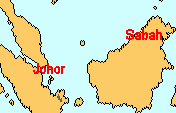

Dugongs used to be common in the Johor Straits, but numbers have been reduced since the 1980s and they were considered locally extinct by some Malaysians. However, they have featured in the news in peninsula Malaysia since late January, when a dugong calf was caught in a fishing net in Johor. The calf was maintained in a kepong or fish trap for nearly six weeks, and became a star attraction during this period. Its carcass was recovered within 48 hours of its being released, causing further controversy. Since then another four dugong carcasses have been recovered in the area, two of them from an abandoned kepong. No food was reportedly found in the stomachs of these animals at necropsy. Two more dugongs were captured by a fisherman and released. I have been invited to go to Malaysia in May to help design a research program.
(Compiled by Helene Marsh from reports in Malaysian newspapers)
October 2000's Sirenews: Evidence For a Resident Dugong Population in the Johor Straits, Between Malaysia and Singapore.  Before 1990, dugongs were rarely reported in the Johor Straits, in Malaysian waters or in Singapore. From 1924 to 1990 there were only 11 known sightings and strandings of dugongs in this area. In contrast, between 1994 and March 1999 reports of 12 strandings, 6 live individuals caught in fishing nets (2 were mother and calf pairs), and 22 aerial survey sightings suggested that dugongs inhabit the area. In fact, dugongs were considered only as transitory in the Johor Straits area until the observations made in 1999 strongly supported the hypothesis that all stranded and sighted individuals might belong to a resident population. The results of genetic studies conducted on 2 stranded juveniles are consistent with the hypothesis of a resident population. They showed that the 2 individuals, washed ashore 2 months apart, were closely related, most likely siblings. As the only social unit identified for dugongs is the cow-calf pair, it is unlikely that siblings would have traveled there from separate home ranges. Furthermore, past research on seagrass distribution combined with the 2 aerial surveys conducted by the Department of Fisheries Malaysia on the 25th of March 1999 and again with the assistance of Professor Helene Marsh on the 11th of May 1999 identified several seagrass beds in the area, some with feeding trails in Halophila ovalis, which is a species preferred by dugongs. Based on the hypothesis of a resident dugong population, long-term research studies have been launched. An integrated study of endangered marine species in the Exclusive Economic Zone waters of Malaysia, with special emphasis on the dugong and its habitat, has been recently proposed by the Department of Fisheries, Malaysia, and the Singapore Wild Marine Mammal Survey project (SWiMMS) also includes dugong distribution and abundance assessments among its main goals.
Before 1990, dugongs were rarely reported in the Johor Straits, in Malaysian waters or in Singapore. From 1924 to 1990 there were only 11 known sightings and strandings of dugongs in this area. In contrast, between 1994 and March 1999 reports of 12 strandings, 6 live individuals caught in fishing nets (2 were mother and calf pairs), and 22 aerial survey sightings suggested that dugongs inhabit the area. In fact, dugongs were considered only as transitory in the Johor Straits area until the observations made in 1999 strongly supported the hypothesis that all stranded and sighted individuals might belong to a resident population. The results of genetic studies conducted on 2 stranded juveniles are consistent with the hypothesis of a resident population. They showed that the 2 individuals, washed ashore 2 months apart, were closely related, most likely siblings. As the only social unit identified for dugongs is the cow-calf pair, it is unlikely that siblings would have traveled there from separate home ranges. Furthermore, past research on seagrass distribution combined with the 2 aerial surveys conducted by the Department of Fisheries Malaysia on the 25th of March 1999 and again with the assistance of Professor Helene Marsh on the 11th of May 1999 identified several seagrass beds in the area, some with feeding trails in Halophila ovalis, which is a species preferred by dugongs. Based on the hypothesis of a resident dugong population, long-term research studies have been launched. An integrated study of endangered marine species in the Exclusive Economic Zone waters of Malaysia, with special emphasis on the dugong and its habitat, has been recently proposed by the Department of Fisheries, Malaysia, and the Singapore Wild Marine Mammal Survey project (SWiMMS) also includes dugong distribution and abundance assessments among its main goals.
At least three live dugongs have been seen off Tanjung Pengeleigh during dedicated aerial surveys, and authorities are talking of gazetting a marine park to provide protection. Meanwhile, fishers have been asked to demolish disused kepongs and to monitor active kepongs regularly.
credits to Frame Dugong Distribution 2
SAVE the DUGONG!;
SAVE the DUGONG!;
SAVE the DUGONG!;
SAVE the DUGONG!;

Labels: credits to http://www.pattayamail.com
SAVE the DUGONG!;
Labels: http://home.iprimus.com.au/readman/dugong.htm
SAVE the DUGONG!;

 The picture shows us seagrass (Potamogetonaceae, Hydrocharitaceae and Cymodoceaceae) which is what dugong feed on. Therefore, dugong can be found at those places that have seagrass so they can feed.
The picture shows us seagrass (Potamogetonaceae, Hydrocharitaceae and Cymodoceaceae) which is what dugong feed on. Therefore, dugong can be found at those places that have seagrass so they can feed.Labels: http://www.unep-wcmc.org
SAVE the DUGONG!;
Y DUGONG!

Dugong is originated from malay word by the meaning of lady of the sea or mermaid.
These species are in vulnerable states, they have the chances of being in extinction characterize it as threatened but not quite as endangered.
5Sc1's STUDENTS ARE HERE TO SAVE THE DUGONG!
email US!
large amount of SEAGRASS
roots
leaves
other marine animal
DUGONG KILLER!
a SAVIOUR!
Raise-Me-Up

^designer
images
artists: lembrancas, B4LU & poopart (from deviantart)